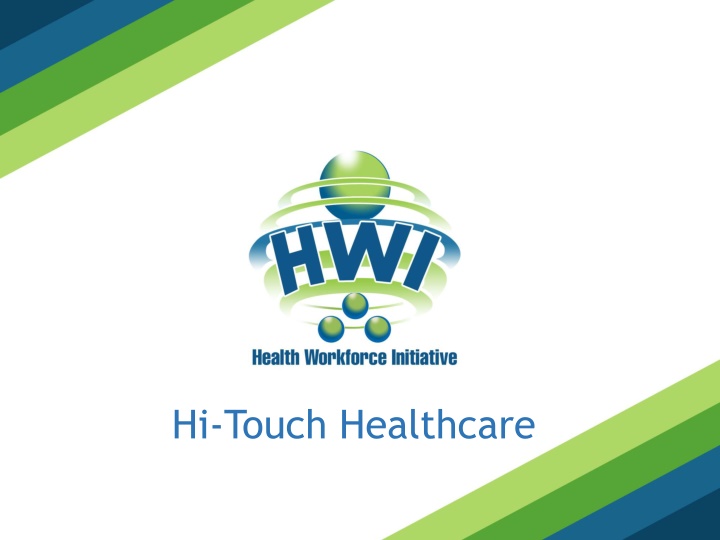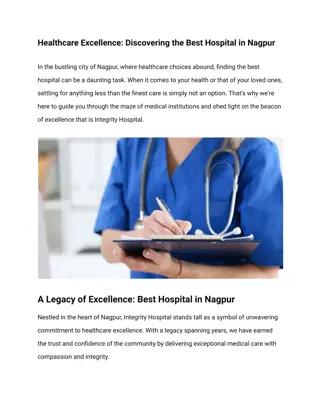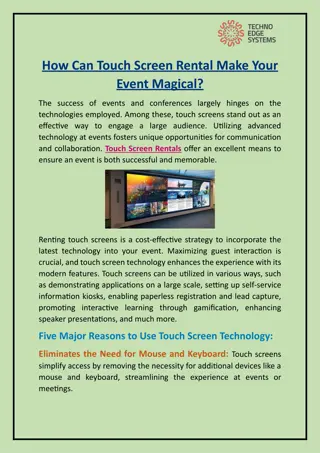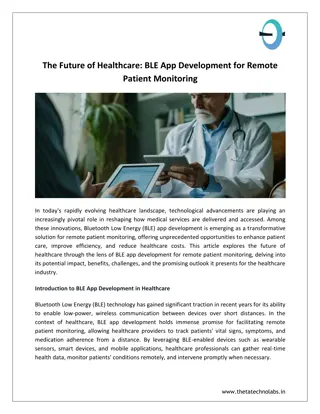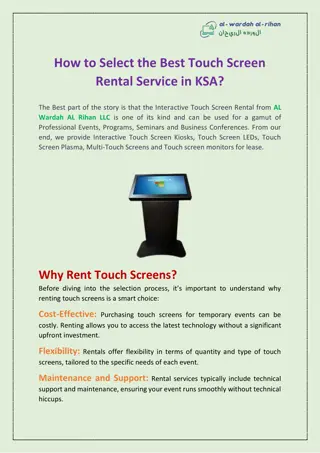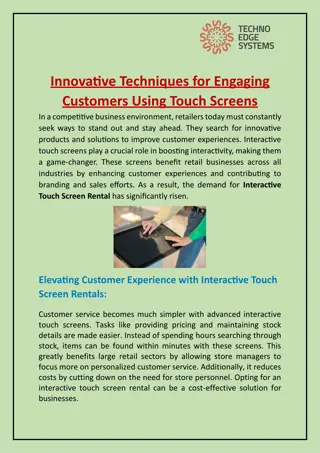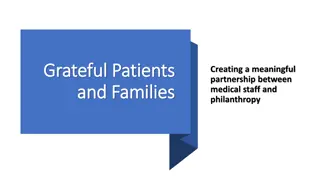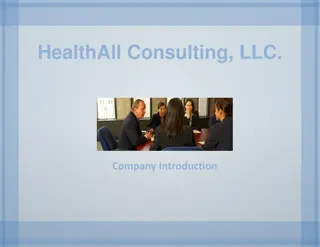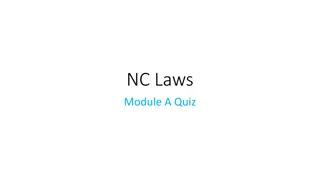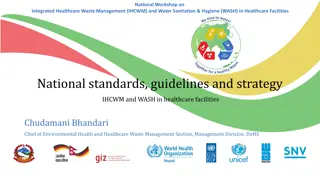Hi-Touch Healthcare
Collaboration in healthcare is crucial for improving patient care, safety, and satisfaction. Effective communication and soft skills play a key role in achieving successful outcomes. Discover why interprofessional collaboration is essential and learn how to build an effective collaborative team.
Download Presentation

Please find below an Image/Link to download the presentation.
The content on the website is provided AS IS for your information and personal use only. It may not be sold, licensed, or shared on other websites without obtaining consent from the author.If you encounter any issues during the download, it is possible that the publisher has removed the file from their server.
You are allowed to download the files provided on this website for personal or commercial use, subject to the condition that they are used lawfully. All files are the property of their respective owners.
The content on the website is provided AS IS for your information and personal use only. It may not be sold, licensed, or shared on other websites without obtaining consent from the author.
E N D
Presentation Transcript
BUILDING AN EFFECTIVE COLLABORATIVE TEAM
WHAT TO EXPECT IN THIS PRESENTATION Overview of the importance of interprofessional collaboration Synergy Quiz Activity Challenges of interprofessional collaboration http://www.healthallianze.com/ha/images/Patient%20Centered%20Care%20for%20Presentation.png Activities Summary
IMPORTANCE OF COMMUNICATION AND SOFT SKILLS Communication is the skill that can possibly have the greatest impact on effective healthcare delivery. It really is the key to clinical governance and demands as much attention, respect, and sustaining as other seemingly harder targets. However, often the mere mention of the importance of communication causes less than positive reactions in healthcare professionals. (Jelphs, 2006, senior fellow at the Health Services Management Centre at the University of Birmingham)
WHY IS INTERPROFESSIONAL COLLABORATION IMPORTANT? http://www.today.mccombs.utexas.edu/sites/default/files/Health%20care%20communications%20illo.jpg Improves patient care Improves patient safety Improves patient satisfaction Improves quality health outcomes Improves job satisfaction and staff retention Reduces costs (Chiocchio, Lebel, & Dube, 2016; Morgan, Pullon, & McKinley, 2015; Naylor, 2011).
WHY IS INTERPROFESSIONAL COLLABORATION NEEDED? Medical specialization Rapid changes in biomedical knowledge and clinical technologies Increasing number of information resources and systems Lack of knowledge about practices, expertise, and responsibilities of others Increasing complexity of health problems Continuity across shifts
SYNERGY QUIZ When instructed, turn over the Synergy Quiz and complete the quiz. When instructed, work with your assigned group to evaluate your answers and to complete the quiz. Designate one member to be the recorder. The recorder will track the group's answers. After the answers have been announced, the recorder should write down both the highest individual score and the group's score.
WHAT IS SYNERGY? Synergy: Superior outcomes that exceed expectations based on skills and abilities of members Occurs when members pool resources/knowledge Occurs when members collaborate Occurs when members use the error correction function https://csql.memberclicks.net/assets/csq%20linked%20puzzle%20pieces.jpg
NEGATIVE SYNERGY Negative synergy: Inferior outcomes based on skills and abilities of members Occurs when the complexity of the task is not clearly assessed Occurs when communication style differences are mishandled Occurs when power dynamics are not understood Occurs when roles and responsibilities are incomplete or ambiguous
WHY IS INTERPROFESSIONAL COLLABORATION CHALLENGING? Reason 1: The complexity of the task is not clearly assessed. Reason 2: Mishandled communication styles differences Reason 3: A lack of understanding of power dynamics Reason 4: Incomplete or ambiguous specifications of roles and responsibilities
WHY IS INTERPROFESSIONAL COLLABORATION CHALLENGING? Reason 1: The complexity of the task is not clearly assessed. Information complexity Accessibility of information Fragmentation of information Domain expertise
MATCH THAT DRUG Interprofessional Collaborative Tasks The task is complex; one person alone does not have the expertise. Individual Tasks There is a best solution and a recognized qualified expert. Conditions are changing rapidly and thus requires coordination by one person. There are several acceptable options. Time is short and the decision must be made quickly/ Acceptance of the solution is critical for an optimal outcome. Group members have difficulty working collaboratively. (Adams & Galanes, 2015, p. 10) Sufficient time exists for interprofessional collaboration. https://upload.wikimedia.org/wikipedia/en/d/dd/Three_circles.png
WHY IS INTERPROFESSIONAL COLLABORATION CHALLENGING? http://qualityteambuilding.com/wp-content/uploads/2013/04/personality.png Reason 2: Mishandled communication style differences The problem is NOT that people have different communication style preferences. The problem IS the lack of understanding about the differences in communication style preferences.
"STYLE STEPPING" 1. Read each one of the questions carefully and choose the answer that is consistent with how you communicate 7 out of 10 times. 2. After answering all the questions, turn to the last page and compute your score. http://thumbs.dreamstime.com/x/taking-test-13618285.jpg
EXECUTER Knows where they want to go Good at managing tasks and results oriented Likes competition A Strengths Take charge, quick decision maker Not afraid to take risks to accomplish goals Weaknesses When stressed, quickly takes over -mistakes happen Can be workaholics May run over feelings to get job done Key Behaviors Direct eye contact Move quickly and briskly with purpose Speak forcefully and fast paced Direct, bottom-line language Use of calendars and planners Mapquest: use to find most expedient route and will have clear plan
ENTHUSIAST B Usually outgoing and persuasive Enthusiastic, friendly, and likes to work with others Loves the spotlight can be very funny Strengths Able to motivate and good at building relationships to achieve goals Works at a fast pace Weaknesses Can seem overwhelming to less assertive types Enthusiasm may override important details Key Behaviors Rapid gestures Speaks quickly and with lots of animation Persuasive language Cluttered workspace with inspirational quotes Mapquest: may not use mapquest and is comfortable being spontaneous
EMPATHETIC C Tends to be responsive and friendly Emotionally expressive but not forceful or direct Strengths Generally good listeners Good team players Weaknesses Trouble with quick decisions Reluctant to deal with conflict---frustration leads to resentment Key Behaviors Friendly Frequent eye contact No aggressive or dramatic gestures Speaks softly and in soft tones Lots of family pictures Mapquest: will use only after consulting with everyone on the trip
EXAMINER D Tends to focus on facts more than feelings Likes organized work area Evaluates situations objectively gathers lots of data before a decision is made Strengths Good problem solver Works independently Weaknesses Facts before feelings may seem distant Under stress can fall prey to analysis paralysis Key Behaviors Little facial expression Controlled body language and slow gestures Little vocal inflection Precise language use and detail-oriented Uses charts, graphs, and statistics Mapquest: use to analyze best route given a specific set of criteria
COMMUNICATION STYLES REVIEW Executer quick decision maker, may run over feelings, moves quickly, calendars, uses Mapquest to find the most expedient route A Enthusiast motivates/builds relationships, can be overwhelming, animated, inspirational quotes, may not use Mapquest B Empathetic good listeners, trouble with quick decisions, speaks softly, family pictures, uses Mapquest after consulting others C Examiner good problem solver, facts before feelings, precise language, charts, and statistics, uses Mapquest after determining criteria D
WHY IS INTERPROFESSIONAL COLLABORATION CHALLENGING? Reason 3: A lack of understanding of power dynamics Power is relative and shifts over time as the resources of specific team members become more or less relevant. Patient safety issues are primarily grounded in inter-team quality communication. (Bleakley, 2013)
POWER RESOURCES 1. Legitimate power: Designated leaders and/or acknowledged positions, education, or titles that provide members with a perceived "legitimate" right to influence us. Reward or punishment power: Member can give or take away items of value (salaries, work schedules, job description, etc.). Expert power: Member has knowledge and/ or skills valued by the group. Referent power: Member is admired and respected and others try to copy his or her behavior. Information power: Member has access to information and controls distribution of information. 2. 3. 4. 5.
WHY IS INTERPROFESSIONAL COLLABORATION CHALLENGING? http://2.bp.blogspot.com/-e1BOLZnnEto/VQbRgddyZwI/AAAAAAAAAAM/KluTz-EFsvM/s1600/1.png Reason 4: Incomplete or ambiguous specifications of roles and responsibilities Clarity of roles ensures patients receive the most appropriate care from the most appropriate healthcare professional. Clarity of responsibilities enhances the effective delegation of duties.
http://homeitalianrecipes.com/wp-content/uploads/2015/01/Spaghetti-11.jpghttp://homeitalianrecipes.com/wp-content/uploads/2015/01/Spaghetti-11.jpg SPAGHETTI CHALLENGE Do NOT open the bag of materials until instructed to do so. You will have 10 minutes to build the best house with the materials provided. http://sr.photos1.fotosearch.com/bthumb/CSP/CSP992/k14137538.jpg
SUMMARY OF INTERPROFESSIONAL COLLABORATION CHALLENGES Reason 1: The complexity of the task is not clearly assessed Reason 2: Mishandled communication style differences Reason 3: A lack of understanding of power dynamics Reason 4: Incomplete or ambiguous specifications of roles and responsibilities
THANK YOU! Questions? Comments?
